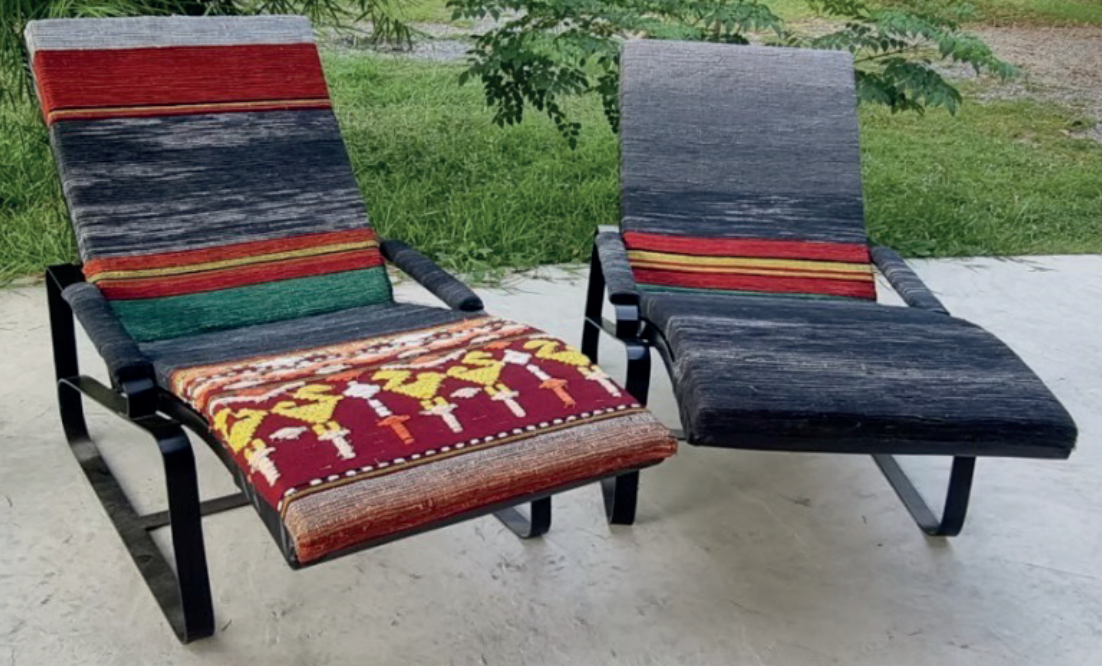“Poo Ying Noong Shin – Poo Chai Kad Pao” From woven fabric to chair, the new products in the dimension of “Jok” fabrics
DOI:
https://doi.org/10.69598/decorativeartsjournal.2.29%20-%2057Keywords:
Chair, New products, Jok fabric, Cultural capital, Tai-yuanAbstract
“Poo Ying Noong Shin-Poo Chai Kad Pao”. “Jok” fabrics are made of modern chair upholstery fabrics from woven cloth. Two Jok-upholstered chairs were included. Each chair set has backrest cushions of varied sizes. Under the project's title, “The Development of Art in Community and the Development of a Local Product for Ratchaburi Creative Smart City,” Jok-fabric-based creative works were shown. It underlined the workpieces' use as the source of craftsmanship's value. Despite this, Jok textiles retained their spiritual value. The following objectives were achieved by this research and its creative elements: 1)Examine the knowledge repositories of cultural capital in local items, particularly Jok textiles and Pa Khao Ma fabrics from Baan Khu Bua, as well as modern art and culture trends related to Ratchaburi Province's way of life and community. 2)Evaluate the strengths, weaknesses, attributes, cultural identity, production method, and potential to integrate several handcraft disciplines into workpieces. 3)Photograph Jok cloth goods as house textiles. 4)Collaborate with the provincial culture office, educational, and private sectors to generate commodities. According to information repositories on the cultural capital of local items, modern art and culture movements in Ratchaburi Province are tied to lifestyle and community. Jok, a famous Tai-Yuan cloth, was the subject of this investigation. After that, concepts, production procedures, and the possibilities of Jok fabrication with fresh dimensions were discussed. According to a demand data synthesis, Tai-Yuan Jok fabrics from Khu Bua Sub District, Ratchaburi Province, would have unique patterns and applications while retaining their individuality. It was also suggested that the chairs, upholstered in contemporary Jok textiles, incorporate the community's view of fabrication's cultural roots. Chairs were designed by families. “Poo Chai Kad Pao” meant dads, whereas “Poo Ying Noong Shin” meant mothers. Simple aluminum chairs with backrests and armrests were used to incorporate these. While the Tai-Yuan fabric designs were kept, the metal structure was replaced with chair cushions in kaleidoscopic Jok textiles. In the new dimensions, manufacturing values were increased by creating stories, making knowledge accessible, and creating images and recognitions for Jok textiles' modern brand. It also used unique consumer targeting orientations to learn and test exemplary items for Ratchaburi Province's sustainable economy.
The findings based on the bodies of knowledge on cultural capital of local products revealed that the trends of the contemporary art and culture interconnected with the lifestyle and community in Ratchaburi Province. The focus of this study was on the Jok fabrics which were the famous products of the Tai-Yuan ethnicity. Afterwards, an analysis and information exchange were performed in terms of concepts, production processes and also possibilities of conducting an experiment of Jok fabrication in new dimensions. The data synthesis from the demands indicated that novelty and patterns of distinct applications which simultaneously preserved the identity of Tai-Yuan Jok fabrics from Khu Bua Sub District, Ratchaburi Province were expected. It also suggested the adoption of the community’s mindset in the cultural roots of fabrication to develop as the design of the “chairs” upholstered with contemporary Jok fabrics. The chairs were inspired by families. “Poo Ying Noong Shin” represented mothers and“Poo Chai Kad Pao” represented fathers.These were integrated with the using of simple metal chair structures with backrests and armrests. The metal solidity was replaced by the chair cushions upholstered with kaleidoscopic Jok fabrics while the fabric patterns of the original Tai-Yuan heritage were still preserved. Furthermore, there were additions of the products’ values in the new dimensions, crafting stories, making the bodies of knowledge accessible, creating images and recognitions in the new dimensions for the contemporary identity of Jok fabrics. It also included the new directions of consumer targeting which led to learning and experimenting development of exemplar products for the sustainable economy of Ratchaburi Province.
References
ประภากร สุคนธมณี. (2564). ๘ นาง ๘ อัตลักษณ์ ไทยวน ราชบุรี. ใน โครงการการบริหารจัดการองค์ความรู้จากศิลปวัฒนธรรมพื้นถิ่นเพื่อพัฒนาสู่แผนการเรียนการสอนในระดับการศึกษาขั้นพื้นฐานและเชื่อมแหล่งเรียนรู้ตลอดชีวิตในชุมชนต่อยอดคุณค่าสู่สังคมอย่างยั่งยืน (หน้า 94-98). กรุงเทพฯ: สนับสนุนทุนวิจัยโดยกองทุนส่งเสริม ววน. และหน่วยบพท.
ภูวนาท รัตนรังสิกุล. (2565). ภูมิปัญญาไทยกับการสร้างสรรค์.พิมพ์ครั้งที่ 2. กรุงเทพฯ : คณะมัณฑนศิลป์ มหาวิทยาลัยศิลปากร.
สำนักงานคณะกรรมการพัฒนาการเศรษฐกิจและสังคมแห่งชาติและศูนย์สร้างสรรค์การออกแบบ.(2552,19 มกราคม). รายงานการศึกษาเบื้องต้นเศรษฐกิจสร้างสรรค์. https://www.nesdc.go.th.

Downloads
Published
How to Cite
License
Copyright (c) 2023 DEC Journal

This work is licensed under a Creative Commons Attribution-NonCommercial-NoDerivatives 4.0 International License.
Published by Academic Affairs Division, Faculty of Decorative Arts, Silpakorn University. The copyright of the article belongs to the article owner. Published articles represent the views of the authors. The editorial board does not necessarily agree with and is not responsible for the content of such articles.


